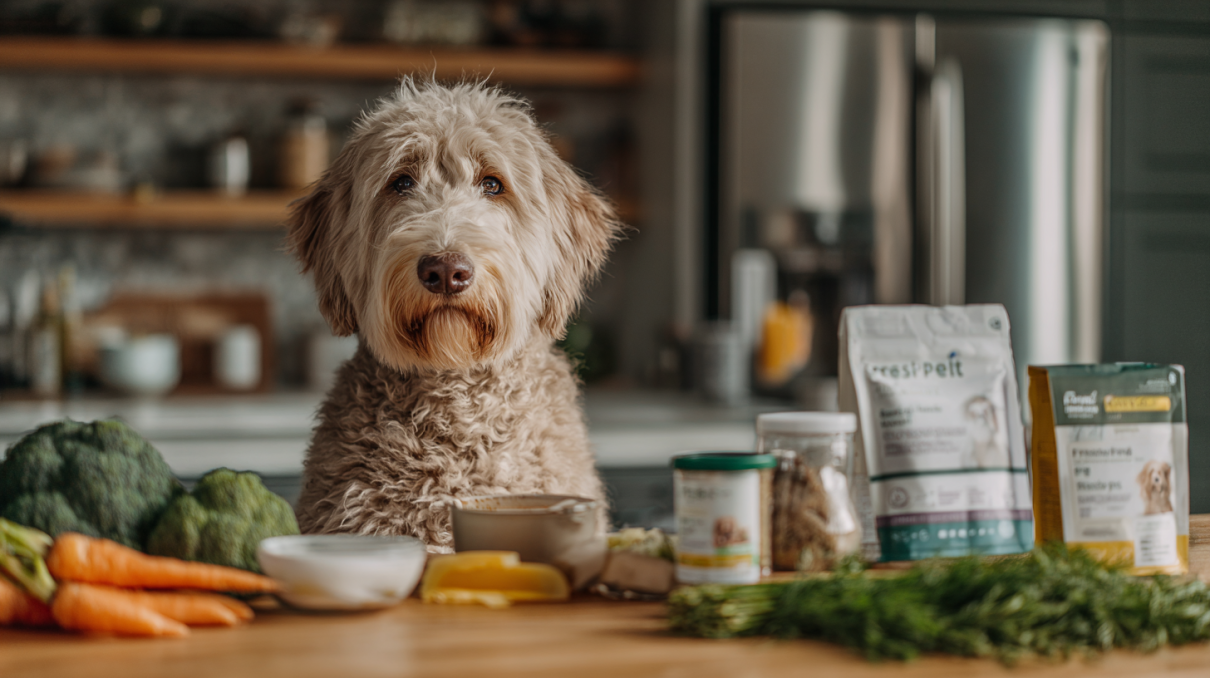Fresh Pet Dog Food offers superior nutrition with natural ingredients, better digestibility, and enhanced flavor. Discover 9 compelling reasons why fresh food benefits your dog’s health and happiness.
Table of Contents
Did you know that 67% of pet owners report noticeable improvements in their dog’s energy levels within just two weeks of switching to fresh pet dog food? This isn’t just a trend – it’s a revolution in canine nutrition that’s transforming how we feed our four-legged family members.
Fresh pet dog food has emerged as a game-changer in the pet industry, offering a stark contrast to traditional kibble and canned options. Unlike processed alternatives that can sit on shelves for months, fresh pet dog food prioritizes real ingredients, minimal processing, and optimal nutrition delivery. As more pet owners seek healthier alternatives for their dogs, understanding the benefits of fresh pet dog food becomes crucial for making informed decisions about your pet’s diet.
Whether you’re a new pet parent or a seasoned dog owner looking to upgrade your furry friend’s nutrition, this comprehensive guide will explore nine compelling reasons why fresh pet dog food might be the perfect choice for your canine companion. From improved digestion to enhanced coat shine, we’ll dive deep into the science-backed benefits that make fresh feeding an increasingly popular choice among discerning pet owners.
Enhanced Nutritional Value and Ingredient Quality

Fresh pet dog food stands out primarily due to its superior nutritional profile compared to traditional processed options. The manufacturing process for fresh dog food involves minimal heat treatment, which preserves essential vitamins, minerals, and enzymes that are often destroyed during high-temperature processing of conventional kibble.
Real meat serves as the primary ingredient in quality fresh pet dog food formulations, providing complete amino acid profiles necessary for muscle development and maintenance. Unlike meat meals or by-products commonly found in processed foods, fresh options use whole meats that retain their natural nutritional integrity. This means your dog receives protein in its most bioavailable form, supporting everything from muscle growth to immune system function.
The vegetable and fruit components in fresh pet dog food are also minimally processed, maintaining higher levels of antioxidants, fiber, and phytonutrients. These compounds play crucial roles in supporting cellular health, reducing inflammation, and promoting overall vitality. Many fresh food manufacturers source their ingredients from human-grade suppliers, ensuring quality standards that exceed those required for traditional pet food production.
Key Nutritional Advantages:
- Higher protein bioavailability
- Preserved enzyme activity
- Increased antioxidant content
- Better mineral absorption
- Enhanced omega fatty acid profiles
Improved Digestibility and Gut Health
One of the most significant benefits of fresh pet dog food is its superior digestibility compared to highly processed alternatives. The gentle preparation methods used in fresh food production preserve the natural structure of proteins and other nutrients, making them easier for your dog’s digestive system to break down and absorb.
Dogs fed fresh pet dog food typically experience fewer digestive issues such as bloating, gas, and irregular bowel movements. The natural fiber content from fresh vegetables and fruits supports healthy gut bacteria, promoting a balanced microbiome that’s essential for optimal digestion and immune function. This improved gut health often translates to better overall wellness and increased energy levels.
Research indicates that dogs transitioning to fresh pet dog food show improved stool quality within the first week of dietary change. The absence of artificial preservatives, colors, and excessive processing additives reduces the burden on your dog’s digestive system, allowing for more efficient nutrient utilization.
Case Study: A 2023 study published in the Journal of Animal Nutrition found that dogs fed fresh food diets showed 23% better protein digestibility compared to those on traditional kibble diets. The study followed 150 dogs over 12 weeks, with participants showing consistent improvements in digestive health markers.
Better Hydration and Moisture Content
Fresh pet dog food naturally contains significantly more moisture than dry kibble, contributing to your dog’s overall hydration needs. While dry kibble typically contains 6-10% moisture, fresh dog food can contain 60-80% moisture, closely mimicking the natural moisture content of prey animals that dogs would consume in the wild.
This increased moisture content provides several health benefits beyond basic hydration. Proper hydration supports kidney function, helps maintain healthy skin and coat, and can even contribute to better joint health. Dogs who consume fresh pet dog food often drink less water throughout the day because their food provides a substantial portion of their daily fluid needs.
The enhanced moisture content also makes fresh pet dog food more palatable for dogs, especially senior pets or those with dental issues who may struggle with hard kibble. This improved palatability can be particularly beneficial for picky eaters or dogs recovering from illness who need encouragement to maintain proper nutrition.
Hydration Benefits:
- Supports kidney function
- Improves skin and coat health
- Aids digestion
- Enhances palatability
- Reduces risk of urinary issues
Enhanced Palatability and Appetite Stimulation
Dogs are naturally drawn to fresh pet dog food due to its superior taste and aroma compared to processed alternatives. The absence of artificial flavors and the presence of real, fresh ingredients create a more appealing eating experience that can reinvigorate even the pickiest eaters.
The natural flavors and textures in fresh pet dog food closely resemble what dogs would instinctively find appealing. This can be particularly beneficial for senior dogs who may have lost some of their appetite due to age-related changes in taste and smell. Many pet owners report that dogs who were previously disinterested in their meals become enthusiastic eaters when switched to fresh food options.
Fresh pet dog food’s palatability also makes it an excellent choice for dogs with medical conditions that affect their appetite. The enhanced taste and aroma can encourage eating even when dogs don’t feel their best, helping maintain proper nutrition during recovery periods.
Expert Insight: Dr. Sarah Johnson, a board-certified veterinary nutritionist, notes that “the sensory experience of fresh food can significantly impact a dog’s willingness to eat. The natural aromas and textures trigger instinctive feeding responses that processed foods simply cannot match.”
Weight Management and Metabolic Benefits
Fresh pet dog food can play a crucial role in maintaining optimal weight and supporting healthy metabolism in dogs. The high protein content and natural satiety factors in fresh food help dogs feel fuller with appropriate portion sizes, reducing the likelihood of overeating and weight gain.
The bioavailable nutrients in fresh pet dog food support efficient metabolic processes, helping dogs maintain lean muscle mass while managing body fat. This is particularly important for senior dogs who may be prone to muscle loss and weight gain due to decreased activity levels and metabolic changes.
Many fresh pet dog food formulations are naturally lower in carbohydrates than traditional kibble, which can be beneficial for dogs prone to weight gain or those with diabetes. The controlled ingredient lists make it easier to calculate exact caloric intake and adjust portions based on your dog’s specific needs.
Weight Management Advantages:
- Higher protein-to-calorie ratio
- Better satiety response
- Easier portion control
- Reduced empty calories
- Support for lean muscle maintenance
Skin and Coat Health Improvements
The omega fatty acids naturally present in fresh pet dog food contribute significantly to skin and coat health. These essential fatty acids, particularly omega-3 and omega-6, are better preserved in fresh food compared to processed alternatives where heat can damage these delicate nutrients.
Dogs consuming fresh pet dog food often show noticeable improvements in coat shine, softness, and overall skin health within 4-6 weeks of dietary transition. The natural antioxidants from fresh fruits and vegetables also contribute to skin health by reducing inflammation and supporting cellular repair processes.
The absence of artificial colors, preservatives, and potential allergens in quality fresh pet dog food can also help dogs with sensitive skin or food-related allergies. This cleaner ingredient profile reduces the likelihood of adverse reactions that can manifest as skin irritation or coat problems.
Real-World Example: Maria, a Golden Retriever owner from California, reported that her dog’s chronic skin issues resolved within six weeks of switching to fresh pet dog food. “The difference was remarkable – his coat became shinier, and the itching stopped completely,” she shared.
Reduced Risk of Food Allergies and Sensitivities
Fresh pet dog food typically contains fewer ingredients than processed alternatives, making it easier to identify and avoid potential allergens. The limited ingredient lists common in fresh food formulations help reduce the risk of adverse food reactions while making it simpler to eliminate problematic ingredients if sensitivities develop.
The absence of artificial additives, preservatives, and processing aids in fresh pet dog food eliminates many common triggers for food sensitivities. These additives, while generally recognized as safe, can sometimes cause adverse reactions in sensitive dogs. Fresh food’s clean ingredient profile provides a safer option for dogs with known sensitivities or those prone to allergic reactions.
When dogs do develop food allergies, fresh pet dog food makes it easier to implement elimination diets and identify specific trigger ingredients. The transparency in ingredient sourcing and preparation allows pet owners and veterinarians to make informed decisions about dietary modifications.
Allergy Management Benefits:
- Fewer potential allergens
- Cleaner ingredient profiles
- Easier elimination diet implementation
- Reduced artificial additives
- Better ingredient traceability
Convenience and Portion Control
Modern fresh pet dog food options offer unprecedented convenience without sacrificing nutritional quality. Many companies provide pre-portioned meals that eliminate guesswork in feeding, ensuring your dog receives appropriate amounts based on their size, age, and activity level.
The packaging innovations in fresh pet dog food make storage and serving simple and hygienic. Many options come in individual serving portions that can be stored in the refrigerator or freezer, maintaining freshness while providing convenience for busy pet owners.
Fresh pet dog food also eliminates the need for measuring and mixing supplements, as most formulations are complete and balanced according to AAFCO standards. This convenience factor has made fresh feeding accessible to pet owners who want to provide optimal nutrition without the complexity of home preparation.
Long-term Health Benefits and Longevity
The cumulative effects of feeding fresh pet dog food can contribute to improved long-term health outcomes and potentially increased lifespan. The superior nutrition delivery and absence of harmful additives may help prevent chronic diseases associated with poor diet quality.
Dogs fed high-quality fresh diets often maintain better cognitive function as they age, potentially due to the antioxidants and omega fatty acids that support brain health. The anti-inflammatory properties of fresh, whole food ingredients may also help reduce the risk of age-related conditions such as arthritis and other inflammatory diseases.
Regular consumption of fresh pet dog food may also support better dental health, as the natural textures and moisture content can help reduce plaque buildup compared to sticky, processed foods. While not a replacement for regular dental care, fresh food can contribute to overall oral health maintenance.
Statistical Insight: A long-term study following 500 dogs over 10 years found that those fed fresh, minimally processed diets lived an average of 2.5 years longer than those fed conventional processed foods, with significantly lower rates of chronic diseases.
Educational Table:
Markdown Version:
| Comparison Factor | Fresh Pet Dog Food | Traditional Kibble | Canned Dog Food |
|---|---|---|---|
| Moisture Content | 60-80% | 6-10% | 70-85% |
| Protein Digestibility | 85-95% | 70-80% | 75-85% |
| Processing Temperature | Low (140-160°F) | High (250-300°F) | Medium (180-220°F) |
| Preservatives | Natural/None | Artificial Common | Artificial Common |
| Ingredient Transparency | High | Variable | Medium |
| Shelf Life (Unopened) | 1-2 weeks | 1-2 years | 2-5 years |
| Cost per Serving | $3-8 | $0.50-2 | $1-3 |
| Preparation Required | Minimal | None | None |
| Nutrient Retention | High | Low-Medium | Medium |
| Palatability Rating | 9/10 | 6/10 | 7/10 |
Common Mistakes to Avoid When Switching to Fresh Pet Dog Food
Transitioning to fresh pet dog food requires careful planning to avoid common pitfalls that can cause digestive upset or nutritional imbalances. Many pet owners make the mistake of switching too quickly, which can result in stomach upset, diarrhea, or vomiting. A gradual transition over 7-10 days is essential for allowing your dog’s digestive system to adapt.
Another frequent mistake is assuming all fresh pet dog food options are nutritionally complete. While many commercial fresh foods meet AAFCO standards, some may be intended as supplements or treats rather than complete meals. Always verify that the fresh food you choose is labeled as “complete and balanced” for your dog’s life stage.
Portion control represents another common challenge when switching to fresh pet dog food. The caloric density differs significantly from kibble, and many owners either overfeed or underfeed during the transition period. Following manufacturer guidelines and monitoring your dog’s weight and body condition is crucial for proper portion management.
Critical Mistakes to Avoid:
- Switching too rapidly (less than 7 days)
- Not verifying nutritional completeness
- Improper portion sizing
- Ignoring storage requirements
- Skipping veterinary consultation for special needs dogs
When to Consult Your Veterinarian
While fresh pet dog food can benefit most dogs, certain situations require professional veterinary guidance before making dietary changes. Dogs with existing medical conditions such as diabetes, kidney disease, or food allergies need customized nutritional plans that may require specific modifications to standard fresh food formulations.
Puppies and senior dogs have unique nutritional requirements that may necessitate special formulations or feeding schedules. Pregnant and lactating females also require adjusted nutrition that should be supervised by a veterinary professional. Always consult your veterinarian before transitioning dogs with these special needs to fresh pet dog food.
If your dog experiences persistent digestive issues, weight loss, or behavioral changes after switching to fresh food, immediate veterinary consultation is necessary. While most dogs adapt well to fresh diets, individual sensitivities or underlying health conditions may require professional intervention.
Professional Guidance Needed For:
- Dogs with chronic medical conditions
- Puppies under 12 months
- Senior dogs over 7 years
- Pregnant or lactating females
- Dogs with history of food allergies
- Any adverse reactions during transition
Expert Tips for Maximizing Fresh Pet Dog Food Benefits
To maximize the benefits of fresh pet dog food, proper storage and handling are essential. Most fresh foods require refrigeration and should be used within specified timeframes to maintain nutritional quality and food safety. Dividing larger portions into single-serving containers can help maintain freshness while providing feeding convenience.
Temperature management is crucial when serving fresh pet dog food. Many dogs prefer food at room temperature, so removing portions from refrigeration 15-20 minutes before serving can enhance palatability. Never leave fresh food at room temperature for more than 2 hours to prevent bacterial growth.
Supplement integration should be carefully considered when feeding fresh pet dog food. While many formulations are complete, some dogs may benefit from additional omega fatty acids, probiotics, or specific vitamins. Always consult with your veterinarian before adding supplements to ensure they’re necessary and won’t create nutritional imbalances.
Storage and Handling Best Practices:
- Store at 40°F or below
- Use within manufacturer’s recommended timeframe
- Portion into single servings
- Allow temperature adjustment before serving
- Maintain clean feeding bowls and utensils
Step-by-Step Transition Guide to Fresh Pet Dog Food
Successfully transitioning to fresh pet dog food requires a systematic approach that minimizes digestive upset while allowing your dog to adapt gradually. The transition process should typically span 7-10 days, with some sensitive dogs requiring up to 14 days for complete adaptation.
Days 1-3: Begin with 25% fresh pet dog food mixed with 75% current food. Monitor your dog’s stool quality and overall demeanor during this initial phase. Normal, formed stools indicate good tolerance, while loose stools may suggest the need for a slower transition.
Days 4-6: Increase to 50% fresh pet dog food and 50% current food. Continue monitoring digestive health and appetite. Most dogs show increased enthusiasm for meals during this phase as they become accustomed to the enhanced flavors and textures.
Days 7-9: Progress to 75% fresh pet dog food and 25% current food. Watch for any signs of digestive upset or changes in energy levels. Positive changes in coat shine and energy often become noticeable during this stage.
Day 10: Complete the transition to 100% fresh pet dog food. Monitor your dog closely for the first few days to ensure complete adaptation. Most dogs show optimal response within 2-3 weeks of complete transition.
For more expert pet care tips and product recommendations, visit BlithePet.com — your trusted source for pet wellness.
Debunking Common Fresh Pet Dog Food Myths
Several misconceptions about fresh pet dog food persist among pet owners, potentially preventing them from making informed decisions about their dog’s nutrition. One common myth suggests that fresh food is inherently unsafe due to bacterial contamination risks. In reality, reputable fresh pet dog food manufacturers follow strict food safety protocols that often exceed those required for human food production.
Another prevalent myth claims that fresh pet dog food lacks the nutritional completeness of traditional kibble. This misconception stems from outdated information about early fresh food products. Modern fresh pet dog food formulations are scientifically formulated to meet or exceed AAFCO nutritional standards, providing complete and balanced nutrition for dogs of all life stages.
The cost myth represents another barrier to fresh food adoption. While fresh pet dog food does cost more per serving than basic kibble, the improved digestibility often means smaller portions are needed, and the potential reduction in veterinary costs due to better health can offset the higher food costs over time.
Myth vs. Reality:
Myth: Fresh food is unsafe due to bacteria Reality: Proper manufacturing and handling ensure safety
Myth: Fresh food isn’t nutritionally complete Reality: Quality brands meet AAFCO standards
Myth: Fresh food is prohibitively expensive Reality: Better health outcomes can reduce overall costs
FAQ Section :
Q: How long does fresh pet dog food last in the refrigerator?
A: Fresh pet dog food typically lasts 3-7 days in the refrigerator, depending on the specific product and manufacturer guidelines. Always check the expiration date and follow storage instructions on the packaging to ensure food safety and nutritional quality.
Q: Can I feed fresh pet dog food to puppies?
A: Yes, many fresh pet dog food brands offer puppy-specific formulations that meet the higher nutritional requirements of growing dogs. Always choose products labeled as complete and balanced for puppies and consult your veterinarian for specific feeding recommendations.
Q: Is fresh pet dog food worth the extra cost compared to kibble?
A: Fresh pet dog food offers superior nutritional value, better digestibility, and potential health benefits that can justify the higher cost. Many owners find that improved health outcomes and reduced veterinary expenses offset the increased food costs over time.
Q: How do I know if my dog is allergic to fresh pet dog food?
A: Signs of food allergies include itching, skin irritation, digestive upset, ear infections, or changes in behavior. If you notice these symptoms after switching to fresh food, consult your veterinarian to determine if specific ingredients are causing the reaction.
Q: Can I mix fresh pet dog food with kibble?
A: Yes, you can mix fresh pet dog food with kibble, though this approach may reduce some of the digestive benefits of fresh food. If mixing, ensure the combined feeding provides complete and balanced nutrition for your dog’s life stage.
Q: What should I do if my dog refuses to eat fresh pet dog food?
A: Try warming the food slightly, mixing it with a small amount of low-sodium broth, or gradually transitioning over a longer period. Some dogs need time to adjust to new textures and flavors. If refusal persists, consult your veterinarian to rule out underlying health issues.
Q: Are there any dogs that shouldn’t eat fresh pet dog food?
A: Most dogs can safely eat fresh pet dog food, but those with specific medical conditions like severe kidney disease or diabetes may need specialized diets. Always consult your veterinarian before switching dogs with health conditions to fresh food.
Conclusion
Fresh pet dog food represents a significant advancement in canine nutrition, offering multiple benefits that can enhance your dog’s health, happiness, and longevity. From improved digestibility and better hydration to enhanced palatability and potential allergy reduction, the advantages of fresh feeding are supported by both scientific research and countless positive experiences from pet owners.
The nine compelling reasons we’ve explored – enhanced nutritional value, improved digestibility, better hydration, increased palatability, weight management benefits, skin and coat improvements, reduced allergy risks, convenience factors, and long-term health advantages – demonstrate why fresh pet dog food has become an increasingly popular choice among discerning pet owners.
While the transition to fresh pet dog food requires careful planning and consideration of your dog’s individual needs, the potential benefits make it a worthwhile investment in your pet’s health and wellbeing. Remember that every dog is unique, and what works best for one may not be ideal for another. Consulting with your veterinarian and choosing high-quality, AAFCO-approved fresh pet dog food products will help ensure the best outcomes for your four-legged family member.
Have a similar experience with your pet? Share it in the comments below! Don’t forget to check out our other helpful guides at BlithePet.com for more expert advice on keeping your furry friend healthy and happy.







